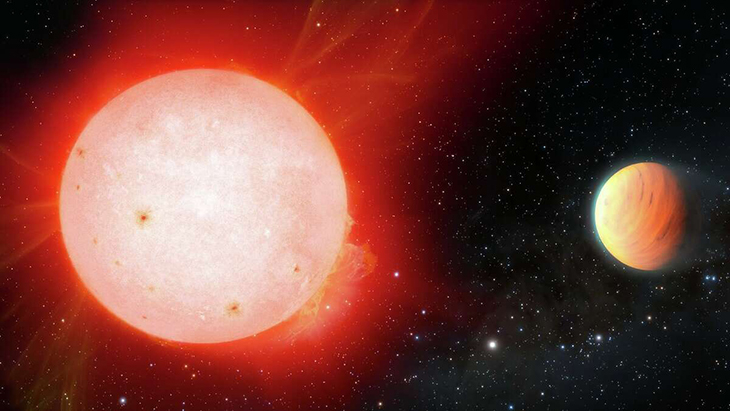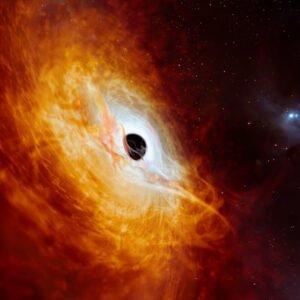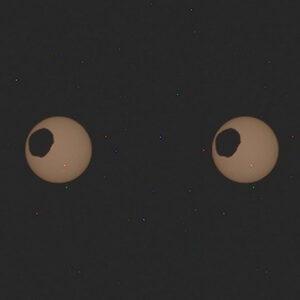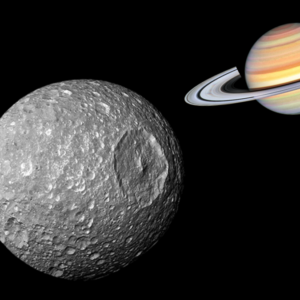
Astronomers have recently come across a planet that has the average density of a marshmallow. Aside from looking soft and fluffy, the scientists also saw that the exoplanet is the same size as Jupiter and because it is gassy, it may just float if it were placed in a giant cosmic bathtub.
Astronomers discovered the interesting planet when they used the Kitt Peak National Observatory telescope in Arizona. They saw this unique-looking planet orbiting around a cool red dwarf star in its area.
The said planet is found approximately 580 light-years from Earth and is in the constellation of Auriga the Charioteer. They later identified it as TOI-3757 b and is the lowest-density planet to be around a red dwarf star.
The average density of TOI-3757 was then calculated and they saw that it was 0.27 grams per cubic centimeter (or about 17 grams per cubic feet). With the numbers they came up with, this would mean that it’s than half the density of Saturn, which is the lowest-density planet known in the Solar System. In other words, this was around one quarter the density of water. Hence, it shared the same density as a marshmallow.
NASA’s Transiting Exoplanet Survey Satellite spotted how this planet crossed in front of its star. This gave the astronomers the chance to calculate the planet’s diameter and they saw this to be around 100,000 miles (or 150,000 kilometers). This makes it just a tad bigger than Jupiter.
As the planet orbits around its host star, it only takes it just 3.5 days, and this is 25-times less than the closest planet in our Solar System, which is Mercury. As for Mercury, this needs around 88 days to do the orbiting. One might assume that this might be enough to heat up and roast the said marshmallow planet. However, it must be noted that red dwarf stars or M dwarf stars can actually be comparatively cool.
That’s because red dwarf stars are the smallest and dimmest members that is part of what they call the main-sequence stars, which are stars that steadily convert hydrogen into helium at their very cores. While this is already cool when compared to our very own un, red dwarf stars can be extremely active. These can erupt with powerful flares that are so strong that they have the capacity to strip the atmosphere off a planet. This makes the star system a hostile location to form such a gossamer planet.
“Giant planets around red dwarf stars have traditionally been thought to be hard to form,” said Shubham Kanodia. She is the first author on a paper that was published in The Astronomical Journal.
“So far this has only been looked at with small samples… which typically have found giant planets further away from these red dwarf stars. Until now we have not had a large enough sample of planets to find close-in gas planets in a robust manner,” she added.
There are so many mysteries that surround TOI-3757 b and many of the questions have yet to be answered. The main question right now is how a gas-giant planet can form around a red dwarf star, and especially such a low-density planet. While this may seem baffling, Kanodia’s team thinks that they might have the answer to this conundrum.
They hypothesized that the extra-low density of TOI-3757 b could be because of two factors. The first one is connected to its rocky core because gas giants are thought to start its life as massive rocky cores that are around ten times the mass of Earth. This is when they are able to quickly pull in large amounts of neighboring gas to form the gas giants that we know of. TOI-3757b’s star doesn’t have that much abundance of heavy elements when placed side by side with other M-dwarfs with gas giants. This may have come about because the rocky core forms more slowly, which delays bringing about the onset of gas accretion that affects its general density.
The second one may be linked to the planet’s orbit, which is assumed to be slightly elliptical. This means that at times, the planet gets closer to its star while sometimes, it doesn’t, which results to substantial excessive heating, something that causes its atmosphere to bloat.
“Potential future observations of the atmosphere of this planet using NASA’s new James Webb Space Telescope could help shed light on its puffy nature,” said Jessica Libby-Roberts. She is the second author on the paper.
“Finding more such systems with giant planets, which were once theorized to be extremely rare around red dwarfs, is part of our goal to understand how planets form,” Kanodia also explained.
What are your thoughts? Please comment below and share this news!
True Activist / Report a typo


